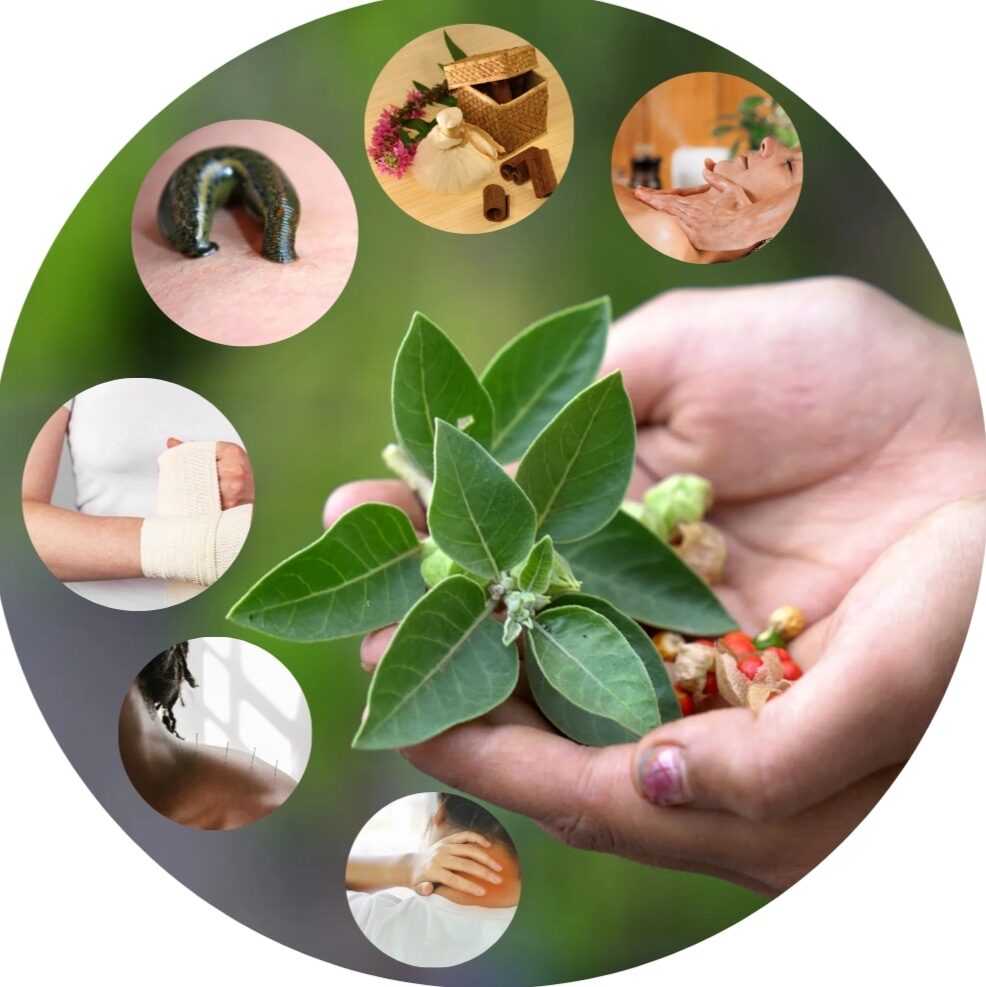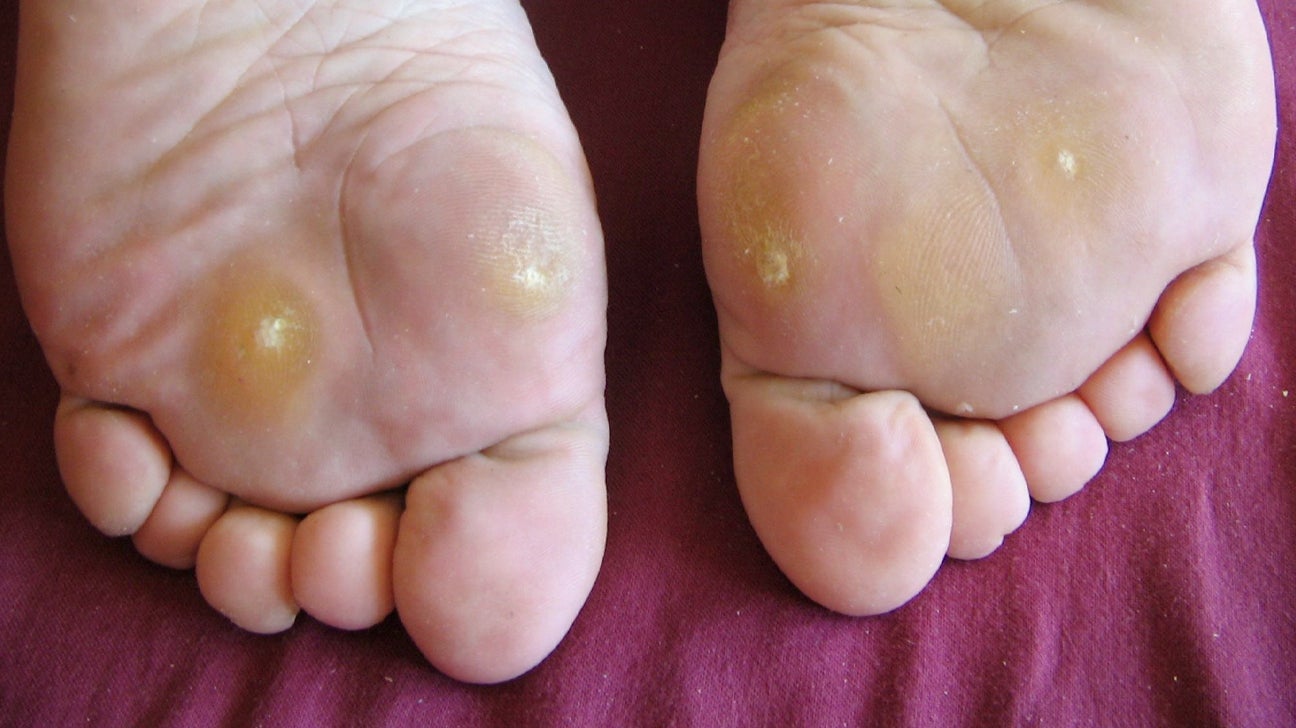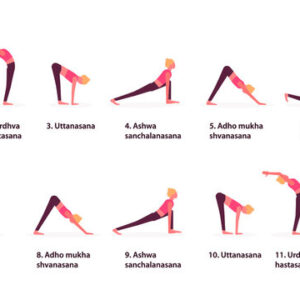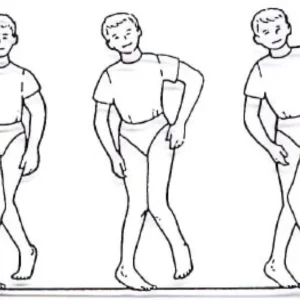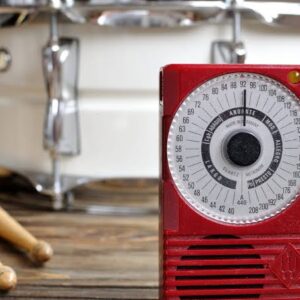Table of Contents
1. Introduction
A corn (medically termed clavus) is a localized thickening of the skin, typically occurring on weight-bearing or friction-prone areas such as the soles and toes. Unlike calluses, corns are smaller, well-defined, and often painful. They represent the body’s natural defense mechanism against repetitive trauma or pressure by increasing keratin production in the epidermis.
The prevalence of corns is high in adults who engage in prolonged standing, ill-fitting footwear, or foot deformities. According to epidemiological data, around 15–35% of adults experience some form of hyperkeratotic lesion of the foot during their lifetime.
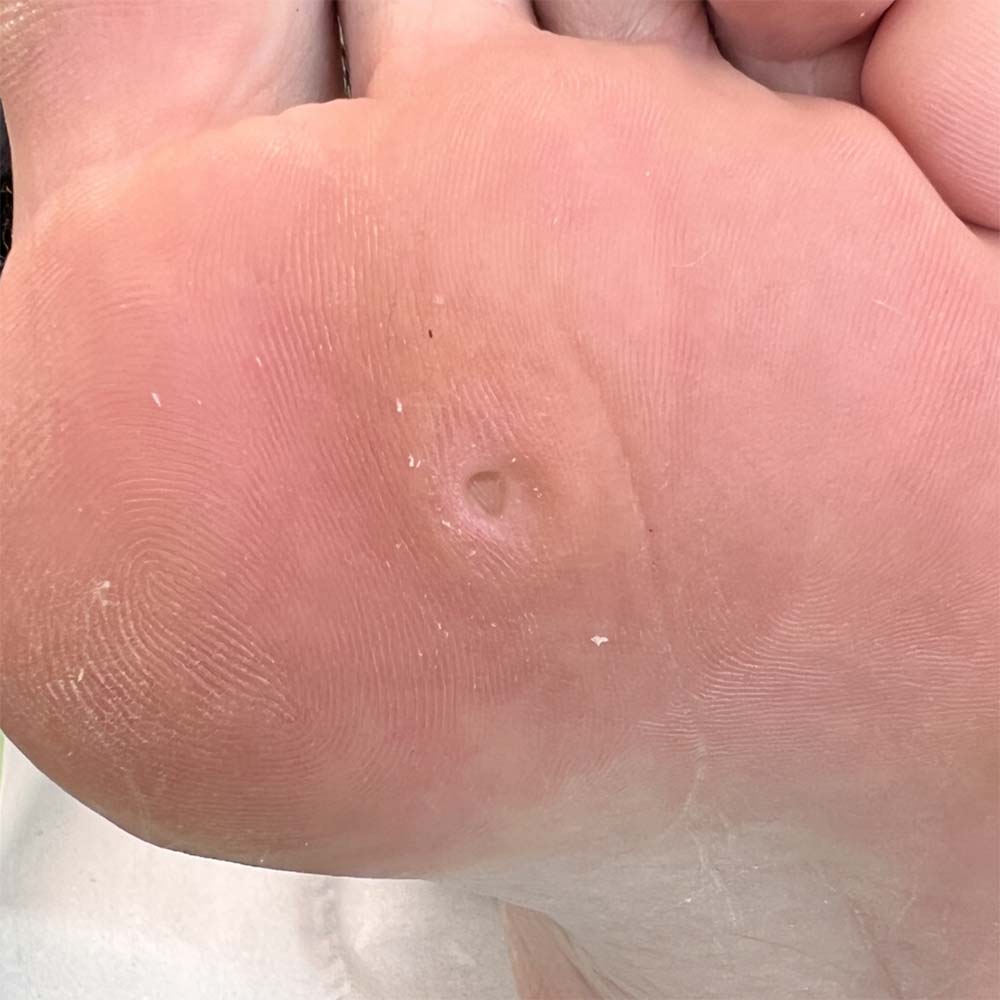
In Ayurvedic texts, similar conditions are described under “Kushtha”, “Charmakeela,” or “Kadara”, depending on the presentation. These conditions are considered Kaphavata predominant disorders associated with local dushti (derangement) of mamsa dhatu and twak (skin) due to pressure, trauma, or doshic imbalance.
2. Modern Aspects and Classification
What Is a Corn (Clavus)?
Corn is defined as a localized hyperkeratotic lesion of the skin resulting from chronic pressure and friction, commonly found on the plantar or digital aspects of the foot. It involves abnormal keratinocyte proliferation and compaction of the stratum corneum.
Types of Corns
Modern dermatology classifies corns into several types:
- Hard Corn (Clavus Durus)
- Most common form.
- Typically occurs on pressure points (e.g., head of metatarsals, dorsum of toes).
- Appears as a small, well-defined, yellowish, keratinous plug with a hard center.
- Painful on direct pressure.
- Soft Corn (Clavus Molle)
- Occurs in moist interdigital spaces.
- Appears whitish and macerated with less central keratinization.
- Painful due to secondary infections.
- Seed Corn (Clavus Milliaris)
- Small keratotic lesions on non–weight-bearing plantar skin.
- Usually multiple and painless.
- Neurovascular Corn
- Involves both nerves and blood vessels.
- Very painful. Bleeding may occur during debridement.
- Fibrous Corn
- Long-standing lesions that have penetrated into deeper dermal layers.
- Often resistant to treatment.
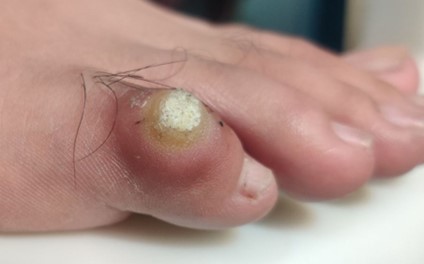
3. Ayurvedic Aspects
Terminology and Correlation
- Kadara is the term used in Ayurveda which closely resembles the clinical picture of a corn.
- Also mentioned as a type of Kshudra Kushtha (minor skin disorder).
- Classical features include localized kathina (hard), vedana yukta (painful), shyava (dark) lesions over the soles or toes.
Dosha Involvement
- Kapha Dosha – leads to increased thickening and growth of tissues (hyperkeratosis).
- Vata Dosha – contributes to pain and hardness due to dryness and constriction.
- Rakta and Mamsa dhatu are involved in deeper stages.
Classical References
- Descriptions of Kadara can be traced in Sushruta Samhita, Charaka Samhita, and Ashtanga Hridaya under Kshudra Kushtha.
- Treatment approaches include lepa (external application), upanaha (poultice), agnikarma (cauterization), and ksharakarma (alkaline cauterization).
4. Comments by Scholars
- Acharya Sushruta highlighted Kadara as a localized skin lesion caused by friction and pressure, recommending Agnikarma for radical removal.
- Acharya Vagbhata emphasized the role of Kapha-Vata aggravation and advised local sodhana and lekhana measures.
- Modern podiatric experts emphasize biomechanical correction and footwear modification alongside local treatment to prevent recurrence.
5. Detailed Physiology and Anatomical Aspects
Skin Physiology and Corn Formation
Corns originate primarily due to abnormal mechanical stress over bony prominences leading to:
- Stimulation of keratinocyte proliferation in the stratum basale.
- Increased compaction of keratin in the stratum corneum.
- Development of a conical keratin plug pointing inward — responsible for pain.
Anatomical Layers Involved:
- Epidermis — mainly the stratum corneum and stratum spinosum.
- Dermis — may be secondarily involved in long-standing lesions.
- Subcutaneous tissue — affected in fibrous or neurovascular corns.
Biochemical and Chemical Changes
- Increased keratin synthesis (keratin 1 and 10 expression).
- Local hypoxia in compressed tissues.
- Secondary inflammatory mediators: IL-1, TNF-α, prostaglandins.
- Peripheral nerve sensitization — causing tenderness.
Ayurveda View of Physiology (Kriya Sharira)
- Vata governs tactile sensation and pain.
- Kapha governs growth and stability of skin tissue.
- Long-standing kapha-vata dushti leads to sthanik mamsa granthi (localized hard swelling).
- Rakta dushti causes discoloration and pain intensification.
6. Causes (Etiopathogenesis)
Modern Causes
- Repeated friction (tight shoes, deformities, abnormal gait).
- Chronic pressure over bony prominences.
- Foot deformities – hammer toe, claw toe, hallux valgus.
- Dry skin and reduced subcutaneous padding in elderly.
- Occupational factors – prolonged standing, walking barefoot.
- Secondary factors – neuropathy, abnormal biomechanics.
Ayurvedic Nidana
- Abhighata (repeated trauma)
- Ati vyayama (excessive walking or standing)
- Atyadhika upayoga of ruksha and kashaya ahara (dry foods aggravating Vata)
- Upasneha dosha and Kapha aggravation locally.
- Dushti of twak, rakta, and mamsa dhatu.
7. Diagnosis
Modern Diagnostic Approach
- History – footwear habits, occupation, duration.
- Inspection – small, well-circumscribed lesion with central keratin plug.
- Palpation – pain on direct pressure; calluses typically painless.
- Dermoscopy – shows central core, absence of dermatoglyphics.
- Differential Diagnosis:
- Plantar wart (verruca) – shows bleeding points, pain on lateral pressure.
- Callus – diffuse thickening, painless.
- Foreign body granuloma.
Ayurvedic Diagnostic Parameters
- Darshana (inspection): kathina, shyava varna, parimita.
- Sparshana (palpation): ruksha, vedana yukta.
- Prashna (history): trauma, footwear habits, occupation.
- Dosha predominance assessment (Kapha-Vata).
8. Detailed Treatment
Modern Therapeutic Management
- Keratolytic Therapy
- Topical keratolytic agents like 40% salicylic acid plasters soften keratin plug.
- Urea creams improve hydration and exfoliation.
- Paring and Debridement
- Removal of keratin plug using scalpel under aseptic precautions.
- Provides immediate pain relief.
- Padding and Orthotic Correction
- Silicone pads or insoles reduce pressure.
- Correction of deformities prevents recurrence.
- Cryotherapy / Laser / Electrocautery
- Used for resistant cases.
- Destroy the keratin plug and reduce local tissue overgrowth.
- Surgical Excision
- Reserved for fibrous or neurovascular corn.
- Requires proper post-operative off-loading.
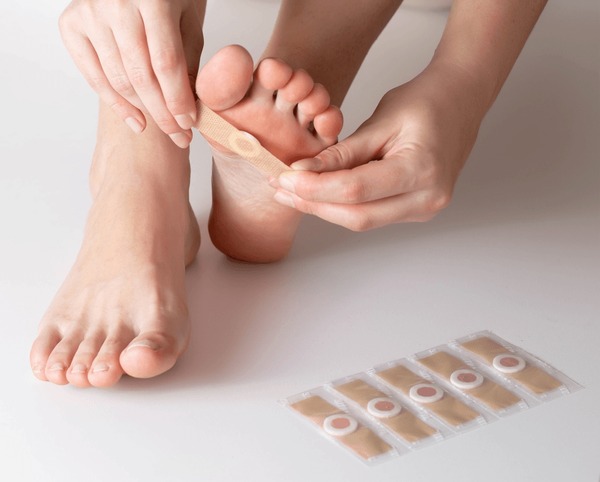
Ayurvedic Therapeutic Protocol
- Sodhana Chikitsa (Purification)
- Seka with warm medicated decoctions (Triphala, Dashamoola) to soften the lesion.
- Snehan with taila (e.g., Karanja taila, Nimba taila) to loosen the plug.
- Lekhaneeya Karma (Scraping)
- Gentle scraping after snehana and swedana to remove thickened skin.
- Ksharakarma (Alkaline cauterization)
- Application of Kshara (e.g., Apamarga kshara) on the lesion for controlled cauterization.
- Neutralized after specified time.
- Agnikarma (Thermal cautery)
- Recommended by Sushruta for stubborn lesions.
- Provides instant relief and minimal recurrence.
- Lepa & Upanaha
- Lepa with Haridra, Daruharidra, Tankana for anti-inflammatory and healing effect.
- Upanaha with warm medicated paste to soften and promote resolution.
- Karuttavattu in arka ksira to be applied.
- Chirattai Tailam
- Shamana Chikitsa (Pacification)
- Internal medications like:
- Kaishora Guggulu
- Gandhaka Rasayana
- Trikatu Churna with honey (for kapha-vata pacification)
- Guggulu tiktakam ghrtam – 10 ml with warm water morning and evening before food
- Guggulu pancaphala curnam – 5 gm with honey morning and night after food
- Rasagandhi mezhuku 1-0-1 with butter milk after food
- Internal medications like:
- Pathya-Apathya
- Avoid prolonged standing, dry and cold food, trauma.
- Use of cushioned footwear and warm water foot soaks.
9. Precautions
- Avoid walking barefoot on hard surfaces.
- Wear well-fitting cushioned footwear.
- Avoid self-cutting of the corn with sharp blades (risk of infection).
- Manage co-morbid conditions like diabetes and neuropathy.
- Regular foot hygiene and moisturizing.
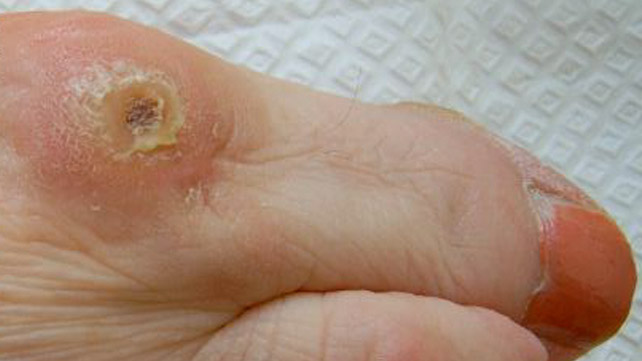
10. Self-Care
- Warm water foot soak with rock salt for 10–15 min daily.
- Application of urea or salicylic acid cream after soaking.
- Gentle filing with pumice stone.
- Protective padding for pressure relief.
- Maintain healthy body weight to reduce plantar pressure.
- Daily inspection of feet in diabetic patients.
11. Conclusion
Corn is a localized, preventable, and manageable skin lesion resulting from mechanical pressure and friction. Modern dermatology provides effective solutions like keratolytics, debridement, and orthotic correction, while Ayurveda offers a holistic, dosha-based approach with sodhana, ksharakarma, and agnikarma. A combination of both systems can provide faster healing, minimal recurrence, and better patient compliance. Early diagnosis, patient education, and preventive foot care are essential.
12. References
- Sushruta Samhita — Kshudra Kushtha Chikitsa Adhyaya.
- Charaka Samhita — Nidana Sthana, Kushtha Nidana.
- Ashtanga Hridaya — Kshudra Roga Chikitsa.
- Rook’s Textbook of Dermatology, 10th Edition.
- Fitzpatrick’s Dermatology, 9th Edition.
- American Academy of Dermatology Association (AAD) — “Corns and Calluses.”
- National Center for Biotechnology Information (NCBI) — Corns and Calluses Review Articles.
- Mayo Clinic — Corns and Calluses Overview.
- PodiaPA: Corn Pathophysiology and Treatment Protocols (2022).
- Bhavaprakasha Samhita — Kadara and Kshudra Kushtha.
13. Our Other articles
Acne Vulgaris: Causes, Pathogenesis, and Risk Factors Explained
Acne Vulgaris: Integrative Ayurvedic and Modern Therapeutic Protocols
Food Safety and Standards Act, 2006: Ensuring Safe & Healthy Food for India
